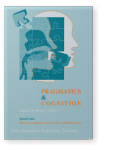Introduction
Discourse-pragmatic markers, fillers and filled pauses
Pragmatic, cognitive, multimodal and sociolinguistic perspectives
This article is available free of charge.
References (42)
References
Aijmer, Karin. 2013. Understanding
pragmatic markers. A variational pragmatic
approach. Edinburgh: Edinburgh University Press. 

Aijmer, Karin & Anne-Marie Simon-Vandenbergen (eds.). 2006. Pragmatic markers in contrast. Oxford: Elsevier. 

Brinton, Laurel. 1996. Pragmatic markers in English: Grammaticalization and discourse functions. Berlin: Mouton de Gruyter. 

Beeching, Kate. 2015. Variability
in native and non-native use of pragmatic markers: The example of well in role-play
data. In Kate Beeching & Helen Woodfield (eds.), Researching
sociopragmatic variability. Perspectives from variational, interlanguage and contrastive
pragmatics, 174–200. Basingstoke: Palgrave Macmillan. 

Beeching, Kate & Ulrich Detges (eds.). 2015. Discourse
functions at the left and right periphery: Crosslinguistic investigations of language use and language
change. Leiden: Brill.
Butterworth, Brian. 1980. Evidence
from pauses in speech. In Brian Butterworth (ed.), Language
production (vol. 11), 155–176. New York: Academic Press.
Buysse, Lieven. 2020. ‘It
was a bit stressy as well actually’: The pragmatic markers actually and in fact in spoken
learner English. Journal of
Pragmatics 1561. 28–40. 

Clark, Herbert & Jean E. Fox Tree. 2002. Using
uh and um in spontaneous
speaking. Cognition 841. 73–111. 

Cooper, William & Jeanne Paccia-Cooper. 1980. Syntax
and speech. Cambridge, MA: Harvard University Press. 

Corley, Martin & Oliver W. Stewart. 2008. Hesitation
disfluencies in spontaneous speech: The meaning of um
. Language and
Linguistics
Compass 2(4). 589–602. 

Corley, Martin & Robert Hartsuiker. 2011. Why
um helps auditory word recognition: The temporal delay hypothesis. PLos
ONE 6(5): e19792. 

Denke, Annika. 2009. Native-like
performance: Pragmatic markers, repair and repetition in native and non-native English
speech. Saarbrucken: VDM Verlag Dr Müller.
Fischer, Kerstin (ed). 2006. Approaches to discourse particles. Oxford: Elsevier. 

Fung, Loretta & Ronald Carter. 2007. Discourse
markers and spoken English: Native and learner use in pedagogic settings. Applied
Linguistics 28(3). 410–39. 

Goldman-Eisler, Frieda. 1961. Hesitation
and information in speech. In Colin Cherry (ed.), Proceedings
of the 4th London Symposium on Information
Theory, 162–174. London: Butterworths.
Goldman-Eisler, Frieda. 1968. Psycholinguistics:
Experiments in spontaneous speech. London: Academic Press.
Hasselgren, Angela. 1994. Lexical
teddy bears and advanced learners: A study into the ways Norwegian students cope with English
vocabulary. International Journal of Applied
Linguistics 4(2). 1313–28. 

Henderson, Alan, Frieda Goldman-Eisler & Andrew Skarbek. 1965. Temporal
patterns of cognitive activity and breath control in speech. Language and
Speech 81. 236–242. 

Henderson, Alan, Frieda Goldman-Eisler & Andrew Skarbek. 1966. Sequential
temporal patterns in spontaneous speech. Language and
Speech 91. 207–216. 

Jehoul, Annelies, Geert Brône & Kurt Feyaerts. 2017. Gaze
patterns and filled pauses: Empirical data on the difference between Dutch euh and
euhm
. In Proceedings of the 4th European and 7th
Nordic Symposium on Multimodal Communication
(MMSYM2016), 43–50.
Kirjavainen, Minna, Ludivine Crible & Kate Beeching. 2022. Can
filled pauses be represented as linguistic items? Investigating the effect of exposure on the perception and production of
um
. Language and
Speech 65(2). 263–289. 

Levelt, Willem J. M. 1983. Monitoring and self-repair in
speech. Cognition 141. 41–104. 

Levelt, Willem J. M. 1989. Speaking: From intention to
articulation. Cambridge, MA: MIT Press.
Liao, Silvie. 2009. Variation
in the use of discourse markers by Chinese teaching assistants in the US. Journal of
Pragmatics 411. 1313–1328. 

Merlo, Sandra & Plínio A. Barbosa. 2010. Hesitation
phenomena: A dynamical perspective. Cognitive
Processing 11(3). 251–261. 

Petrie, Helen. 1987. The
psycholinguistics of speaking. In John Lyons, Richard Coates, Margaret Deuchar & Gerald Gazdar (eds.), New
horizons in
linguistics (vol. 21), 336–366. Harmondsworth: Penguin.
Pichler, Heike (ed.). 2016. Discourse-pragmatic
variation and change in English: New methods and
insights. Cambridge: Cambridge University Press. 

Schiffrin, Deborah. 1987. Discourse
markers. Cambridge: Cambridge University Press. 

Speer, Shari R., Paul Warren & Amy J. Schafer. 2011. Situationally
independent prosodic phrasing. Laboratory
Phonology 2(1). 35–98. 

Swerts, Marc. 1998. Filled
pauses as markers of discourse structure. Journal of
Pragmatics 30(4). 485–496. 

Tonetti Tübben, Ilenia & Daniela Landert. 2022.
Uh
and um as pragmatic markers in dialogues: A contrastive perspective on the functions of planners in fiction
and conversation. Contrastive
Pragmatics. 1–32. 

Tottie, Gunnel. 2019. From
pause to word: Uh, um and er in written American
English. English Language and
Linguistics 23(1). 105–130. 

Traugott, Elizabeth Closs & Richard B. Dasher. 2002. Regularity
in semantic change. Cambridge: Cambridge University Press.
Zaides, Kristina Denisovna. 2022. Hesitative markers
eto and eto samoe: Structural and temporal aspects. Коммуникативные
исследования 9 (1). 49–66.
Cited by (2)
Cited by two other publications
Beradze, Marianna & Natalia Meir
2024.
Disfluencies as a Window into Pragmatic Skills in Russian-Hebrew Bilingual Autistic and Non-Autistic Children.
Journal of Autism and Developmental Disorders 
Koteyko, Nelya, Martine Van Driel, Sofia Billan, Belen Barros Pena & John Vines
2024.
Stigma Management Strategies of Autistic Social Media Users.
Autism in Adulthood 
This list is based on CrossRef data as of 21 september 2024. Please note that it may not be complete. Sources presented here have been supplied by the respective publishers.
Any errors therein should be reported to them.
